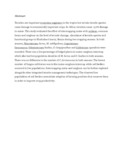| dc.contributor.author | Kanyi, N. C. | |
| dc.contributor.author | Karuri, H. | |
| dc.contributor.author | Nyasani, J. O. | |
| dc.contributor.author | Mwangi, Benson | |
| dc.date.accessioned | 2021-12-14T06:57:03Z | |
| dc.date.available | 2021-12-14T06:57:03Z | |
| dc.date.issued | 2022-03 | |
| dc.identifier.citation | Crop Protection Volume 153, March 2022, 105881 | en_US |
| dc.identifier.uri | https://www.sciencedirect.com/science/article/abs/pii/S0261219421003513 | |
| dc.identifier.uri | http://hdl.handle.net/123456789/5485 | |
| dc.identifier.uri | https://doi.org/10.1016/j.cropro.2021.105881 | |
| dc.description.abstract | Termites are important ecosystem engineers in the tropics but certain termite species cause damage to economically important crops. In Africa, termites cause >50% damage in maize. This study evaluated the effect of intercropping maize with soybean, common beans and sorghum on the level of termite damage, abundance of termite species and functional groups in Machakos County, Kenya during two cropping seasons. In both seasons, Macrotermes herus, M. subhyalinus, Coptotermes formosanus, Odontotermes badius, O. longignathus and Cubitermes ugandesis were recorded. There was a low percentage of lodged plants in maize-sorghum intercrop which also had low population densities of M. herus and O. badius in both seasons. There was no difference in the number of C. formosanus in both seasons. The lowest number of fungus-cultivators was in the maize-sorghum intercrop while soil feeders occurred in low populations. Intercropping maize and sorghum can be further explored alongside other integrated termite management techniques. The observed low populations of soil feeders necessitate adoption of farming practices that conserve them in order to improve crop productivity. | en_US |
| dc.language.iso | en | en_US |
| dc.publisher | Elsevier | en_US |
| dc.title | Termite species and functional groups in maize intercrop systems in Machakos County, Kenya | en_US |
| dc.type | Article | en_US |

